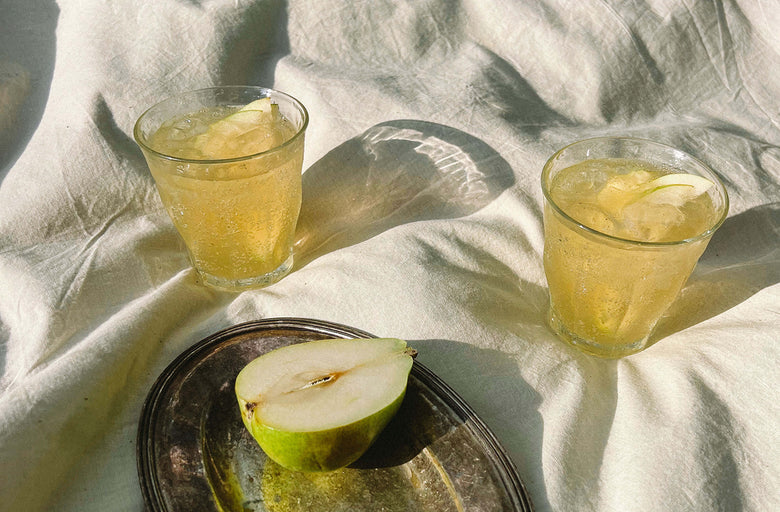Here’s a riddle for you: Not everything that’s pickled is fermented, and not everything that’s fermented is pickled. Stumped? You’re not alone — the two are often confused. Yet, if you’ve been with us this month as we’ve been exploring the wild, wonderful world of the microbiome, you’ve heard that fermented foods are an important part of a diet that nourishes your gut flora, which in turn leads to optimal wellness. Take it from Dr. Robynne Chutkan, who quite literally wrote the book on the microbiome: “[Fermented foods] act as a prebiotic, meaning they provide food for our gut bacteria, and the fermentation process also produces additional live bacteria. Foods like sauerkraut, kimchi and pickles contain live bacteria from the fermentation process and also lots of fiber.”
Before you start wandering the aisles of your local health food store in a daze or, worse, grab any old jar of dill pickles off the shelf in a (futile) search for microbiome bliss, check out this S-Life-approved pickling vs. fermenting study guide.
FIRST, PICKLING…
This is the process of preserving foods in an acidic medium, most often vinegar, along with herbs and spices. No live probiotics or enzymes are present in these foods because they’re heated for sterilization and preservation purposes, a process that kills off all the healthy bacteria (as well as diminishes the potency of nutrients like Vitamin C). It doesn’t mean a crunchy dill pickle isn’t delicious but it does mean said pickle isn’t doing much for your gut health.
FERMENTING, ON THE OTHER HAND…
Scientifically speaking, fermentation is a metabolic process whereby sugars are converted to acids, gases or alcohol. In the case of truly fermented sauerkraut or kimchi, the acidic medium in which the vegetables are cultured is a byproduct of the process itself. In DIY fermentation, should you be so inclined, it begins with filtered water and salt or a starter culture, and results in the presence of lactic acid, produced by the live (healthy) bacteria Lactobacillus. That’s the good stuff — it diversifies your gut flora, aids digestion and gives you a glow. (No wonder we included several strains of Lactobacilli in our Complete Probiotic Formula.) Lactic acid bacteria is pretty much the only thing that can survive in the highly acidic environment created by fermentation, so in that respect, this process also acts as a natural preservative, protecting the cultured veggies from rotting over time.
POP QUIZ!
Q: What is pickled, but not fermented?
A: Shelf-stable pickles (and other veggies) in a jar
Q: What is fermented AND pickled?
A: Sauerkraut, kimchi and other related products, found in the refrigerated section* of the grocery store
Q: What is fermented, but not pickled?
A: Alcohol (beer, wine etc.)
*IMPORTANT! If your fermented veggies aren’t found in the refrigerated section of the store, they’re of no use to you (beyond being tart, tasty condiments). These shelf-stable “ferments” are made using pressure and/or heat, and therefore don’t possess the live, active cultures that you’re in this for. And as always, organic is best!
BONUS ROUND! S-LIFE SAUERKRAUT RECIPE
INGREDIENTS:
~ 1 head of organic cabbage (purple or green, your call!)
~ 1 TBSP pink Himalayan salt
DIRECTIONS:
Discard the outer leaves of the cabbage, and begin slicing the rest into very thin shreds. Place shreds into a large mixing bowl, and sprinkle Himalayan salt throughout. Begin to massage cabbage shreds with your hands, working the salt into the fiber. Continue on with this for 10 - 20 minutes, or until the cabbage has significantly softened, and is quite wet. Then, transfer the salty, softened cabbage shreds into a one-liter large mason jar. Be sure to pack the cabbage into the jar as tight as possible. Cover the jar with a cloth and secure with string or a rubber band, and allow to sit at room temperature (and out of direct sunlight!) for somewhere between 3 - 10 days, depending on your climate environment, and whether or not the AC is blowing (cabbage ferments significantly faster in warm, humid climates). After a few days, scoop your fork in and have a taste — if things seem as fermented as you'd like, then go for it, and begin adding to meals! Once fermented to your liking, store in the fridge for up to two weeks.






